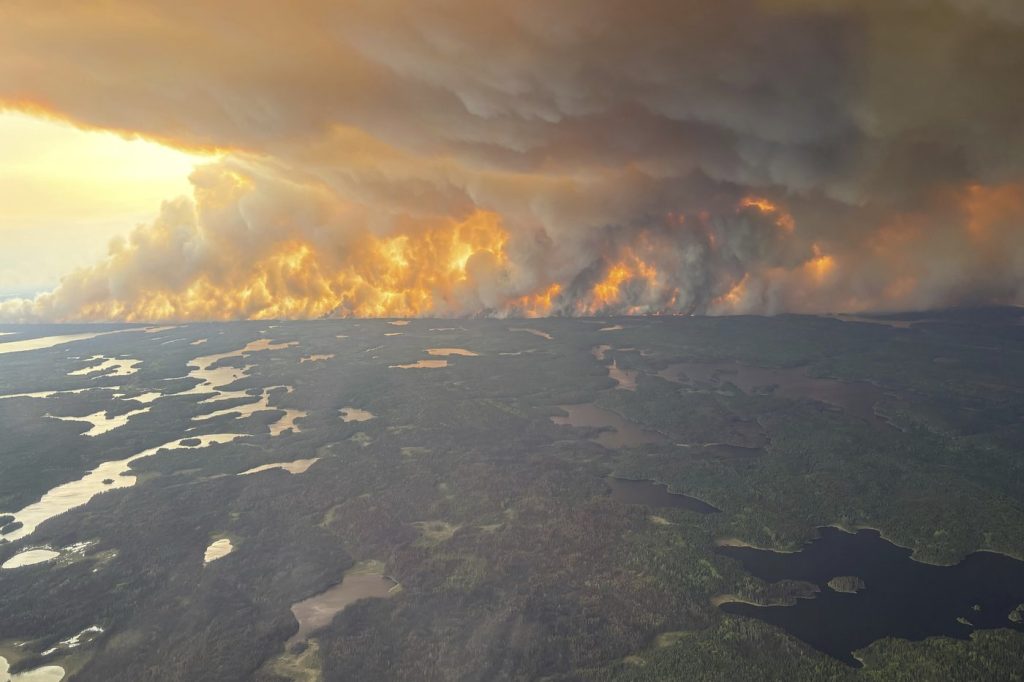Air quality in several regions of the United States is deteriorating as smoke from numerous wildfires in Canada drifts southward, propelled by high-altitude winds. Regions in Minnesota and Wisconsin are currently experiencing unhealthy air quality levels, particularly for sensitive individuals, such as those with pre-existing health conditions, according to the Environmental Protection Agency’s AirNow platform.
As of Friday afternoon, an interactive air quality map indicated a sizeable strip of orange, denoting unhealthy air, moving across Wisconsin. Most of Wisconsin and all of Michigan's Upper Peninsula were marked with moderate air quality, while eastern Iowa and northwestern Illinois reported similar moderate levels. Meteorologist Patrick Ayd from the National Weather Service in Duluth, Minnesota, noted that over the next day, particulates from the wildfires may spread even further south into Oklahoma, Tennessee, and Arkansas.
Local business owner Murray Kinsey, who operates a houseboat company near Babbitt, Minnesota, described the atmosphere as "hazy" but remarked that fishing activities on Birch Lake continued. “It’s getting a little hard to breathe,” he stated, yet added, “It’s not terrible. We’ve had it before, but it’s been way worse.”
The Air Quality Index (AQI) is utilized to assess the cleanliness or pollution levels of the air we breathe on a daily basis. It emphasizes potential health impacts that individuals may experience shortly after exposure to polluted air. The AQI is derived from levels of ground-level ozone, particulate matter, carbon monoxide, sulfur dioxide, and nitrogen dioxide, with ground-level ozone and particulate matter being the most significant health threats.
The AQI scale ranges from green, indicating satisfactory air quality, to maroon, which signifies hazardous conditions that could affect everyone’s health. On Friday morning, the AQI around the Arrowhead region of Minnesota was orange, indicating concern for those with chronic health issues, seniors, and young children. Ayd advised these groups limit their outdoor activities.
The orange AQI zone progressively shifted southward throughout Friday afternoon. Areas with yellow readings, indicating moderate air quality, were also noted across parts of the Midwest. Chicago was also projected to experience smoke from the Canadian wildfires, potentially encountering scattered thunderstorms in the evening.
Meteorologist Zachary Yack remarked, “It looks like the smoke is moving in behind the cold front. Most of the smoke is thinning behind the front.” However, levels of fine particulates are expected to reach the red AQI level in northern Minnesota, classified as unhealthy for everyone, which has led the Minnesota Pollution Control Agency to issue advisories for limiting outdoor activities.
In terms of preventative measures, it’s recommended for individuals to remain indoors with windows and doors closed, avoid engaging in strenuous outdoor tasks, and refrain from using outdoor air ventilation systems, wood-burning appliances, or igniting candles and incense to minimize exposure to poor air quality.
The wildfires in Canada are primarily located in Manitoba, just north of Minnesota and North Dakota, where nearly two dozen fires are currently active. As of this year, the region has faced over 100 wildfires. Recently, Manitoba declared a state of emergency due to these fires, causing the evacuation of 17,000 residents from various communities.
Canada’s wildfire season spans from May to September, and 2023 was reported as their most severe wildfire season on record, enveloping much of North America in hazardous smoke for extended periods. Meteorologist Kevin Doom from the National Weather Service in Chicago noted the impact of these winds at altitudes of 10,000 to 20,000 feet, which are currently blowing southward into the U.S. He confirmed that Minnesota is currently suffering the most significant effects of the smoke.
In recent years, wildfires have drastically affected air quality across the country, with past summers witnessing smoke particles drift from large wildfires in California, Oregon, Arizona, Washington state, and Canada. This situation has prompted local authorities to issue air quality alerts and advisories for residents in affected areas.












